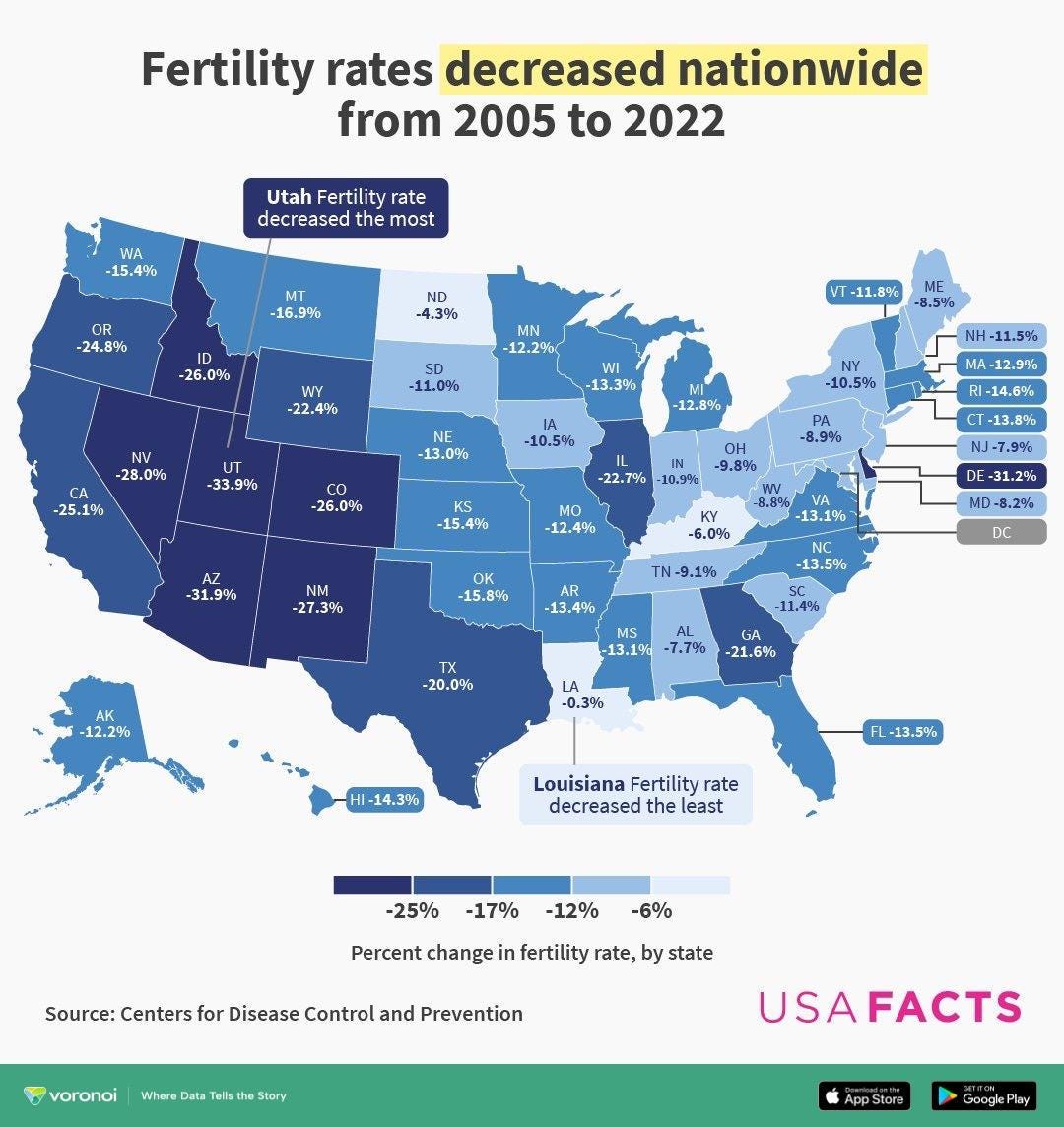Repronews #57: Preimplantation genetic testing market to almost double by 2031
Ferguson on fertility crisis; genes & athletic ability; polygenics of brain disorders; genetics of sucrose & craving; Animal Breeding Index; biotech vs. mosquitoes

Welcome to the latest issue of Repronews! Highlights from this week’s edition:
Repro/genetics
The preimplantation genetic testing (PGT) is forecast to almost double to $1.2 billion by 2031, driven by innovation and emerging markets
Population Policies & Trends
Niall Ferguson on the fertility crisis as “capitalism’s next challenge”
Genetic Studies
Twin study finds genetic factors explain 52-79% of performance for different athletic abilities.
Polygenics: common genetic variants can influence the risk of rare childhood neurodevelopmental disorders and adult depression and schizophrenia.
Nutrigenetics: genetic inability to digest sucrose linked to less craving for sugary treats.
Further Learning
Animal breeding index: Maeve Williams explains how genetic technologies have enhanced breeding for milk production and reduced carbon emissions.
Djibouti experiments with gene editing to suppress malaria-carrying mosquitos
Repro/genetics
“Preimplantation genetic testing market to reach $1.2 billion by 2031” (PR Newswire)
The global Preimplantation Genetic Testing (PGT) market is projected to almost double approximately $0.67 billion in 2024 to $1.2 billion by 2031. The compound annual growth rate (CAGR) is around 8%.
The PGT market’s growth is driven by increasing demand for IVF procedures, advancements in genetic testing technologies, and rising awareness of hereditary genetic disorders.
Government support for reproductive health and fertility treatments is facilitating use of PGT. The number of fertility clinics is rising, particularly in regions with low birth rates, high infertility cases, and rising maternal age.
Innovations, such as next-generation sequencing (NGS) and polymerase chain reaction (PCR), are enhancing PGT’s ability to detect genetic abnormalities.
The adoption of PGT in emerging economies is expected to rise with improving healthcare infrastructure.
The PGT market is growing rapidly in China, Japan, and India due to a rising focus on reproductive health, improving healthcare systems, and a growing population of women opting for fertility treatments.
Emerging markets in Latin America and the Middle East are also contributing to global growth.
Accessibility and affordability of PGT treatments are likely to increase.
Online platforms for patient education and community support are raising awareness of genetic testing options, while social media campaigns are increasingly used to promote awareness and share success stories related to PGT, encouraging more couples to consider genetic screening.
The PGT market faces challenges such as high costs and regulatory complexities in some regions. The affordability of IVF and PGT remains a concern, particularly in low- to middle-income countries. The lack of comprehensive insurance coverage for these treatments limits accessibility.
Ethical concerns surrounding embryo manipulation and genetic testing are also leading to regulatory hurdles and barriers to growth in some countries.
More on repro/genetics:
“Netherlands: 400 donor-conceived people have more than 25 half siblings”(PET)
“Republican politicians oppose IVF funding for the military” (PET)
“10 years of womb transplants: What have we learned?” (PET)
“‘Look, they’re getting skin!’: are we right to strive to save the world’s tiniest babies?” (Guardian)
“Embryo-swap parents work together to find resolution” (PET)
Anti-diabetes drug semaglutide could improve sperm quality in men with obesity and type 2 diabetes (PET)
Population Policies & Trends
“The fertility crisis: Capitalism’s next challenge” (Stigler Center)
Conservative historian Niall Ferguson discusses global population decline and its implication for civilization.
He discusses climate change, immigration, reproductive rights, AI, and the trade-offs women face between career and motherhood affecting reproductive decisions.
If the U.S. fertility rate were to stay at 1.64 per woman, without immigration the country’s young population be cut in half within 3 generations.
Just eight countries are expected to account for more than half the rise in global population between now and 2050. Africa’s share of global births is set to rise from 29% in 2021 to 41% in 2050.
More on population policies and trends:
Mohan Bhagwat, leader of Rashtriya Swayamsevak Sangh (RSS), a major nationalist group, warned about fertility falling under 2.1 (Times of India)
“Forced hysterectomy or societal surrogacy—an ethical solution for falling birth rates?” (PET)
Genetic Studies
“Are athletes born or made? A new study reveals which fitness traits are primarily genetic” (Outside)
A study published in Medicine & Science in Sports & Exercise assesses physical fitness in 198 Portuguese twin pairs (40% identical twins) through 15 tests from the Eurofit and Fitnessgram test batteries.
Girls performed better than boys in flexibility. Boys performed better than girls in cardiorespiratory endurance and muscular strength.
No sex differences were found in the influence of genetic factors on the physical fitness tests or their mutual correlations.
Genetic factors explained 52% (standing long jump) to 79% (sit and reach) of the individual variation in motor performance.
Most tests showed modest to moderate genetic correlations between them. Tests measuring the strength of different muscle groups showed only modest correlations, but moderate correlations were found between tests measuring explosive strength, running speed/agility, and cardiorespiratory endurance.
In conclusion, genetic factors explained a major portion of the variation in tests and explained the correlations between them. The modest to moderate genetic correlations indicated that there is little redundancy of tests in either Eurofit or Fitnessgram test batteries.
“Common gene variants can influence risk of rare neurodevelopmental conditions” (PET)
Another study has found that common genetic variants can influence risk of developing rare disorders, in this case neurodevelopmental conditions in children.
Some of these variants are also linked to risk of developing schizophrenia and depression in later life.
Researchers from the Wellcome Sanger Institute and collaborators looked at genomic data from thousands of children with rare neurodevelopmental conditions, and their parents to investigate the influence of genetic variants.
Variants common in people of British ancestry can explain close to 10% of the chance of having a developmental disorder. The contribution was higher in children lacking a monogenic condition.
“It’s important that we understand the cause of neurodevelopmental conditions in all patients, not only those with a clear-cut single-gene diagnosis,” said senior author Dr. Hilary Martin.
Genetic variants that are common (present in more than one out of 100 people) often have very little impact on human diseases or traits on their own. However, a single genome carries millions of them—this is known as the “polygenic
background”—the degree to which it can influence monogenic traits is unclear.
The researchers used genomic data from two UK-based projects to compare the genomes of more than 11,500 people who had a rare developmental condition to 9100 of their parents and 26,800 people who did not.
Variants linked to psychiatric conditions including schizophrenia were also common in children who had rare neurodevelopmental disorders, suggesting common biological mechanisms between them.
Genetic variants previously linked to spending fewer years in education were found to underpin the common genetic variability shared between other neurodevelopmental disorders and mental health conditions such as depression and attention-deficit hyperactivity disorder (ADHD)
This supports the “liability threshold model” theory which predicts that, if a person is diagnosed without a large-effect variant, such as a known monogenic disorder, then more common and rare variants that modify the risk are likely to be present.
“Could a genetic flaw be the key to stopping people craving sugary treats?” (University of Nottingham)
An international study, published in Gastroenterology, shows that genetic variations in the sucrase-isomaltase (SI) gene are associated with the intake, and preference, of sucrose-rich foods.
Large population-based cohorts showed people with genetic defects in sucrose digestion eat fewer cakes, pastries, candy, and chocolate and like foods less as their sucrose content increases.
“Excess calories from sugar are an established contributor to obesity and type 2 diabetes. In the UK, we consume 9-12% of our dietary intake from free sugars, such as sucrose, with 79% of the population consuming up to three sugary snacks a day,” said Dr. Peter Aldiss, study lead and group leader in the School of Medicine at the University of Nottingham. “Now, our study suggests that genetic variation in our ability to digest dietary sucrose may impact not only how much sucrose we eat, but how much we like sugary foods.”
The team of experts began by investigating the dietary behaviours in mice lacking the SI gene. Here, mice developed a rapid reduction in sucrose intake, and preference. This was confirmed in two large population-based cohorts involving 6,000 individuals in Greenland and 134,766 in the UK BioBank.
The team took a nutrigenetics approach to understand how genetic variation in the SI gene impacts sucrose intake and preference in humans.
Individuals with a complete inability to digest dietary sucrose in Greenland consumed significantly less sucrose-rich foods whilst individuals with a defective, partially functional SI gene in the UK, liked sucrose-rich foods less.
“In the future, understanding how defects in the SI gene act to reduce the intake, and preference, of dietary sucrose will facilitate the development of novel therapeutics to help curb population-wide sucrose intake to improve digestive and metabolic health,” said Dr. Aldiss.
Further Learning
“How genetics has changed the science of animal breeding” (RTÉ)
Agricultural genetics researcher Maeve Williams explains how Ireland’s animal breeding index is used to measure the genetic merit of animals based on everything from milk production to carbon emissions
Animal breeding aims to exploit the small genetic differences between animals— a less than 1% difference—to raise more economically, environmentally, and socially sustainable animals.
For thousands of years, farmers improved the genetic merit of their animals by breeding animals with desirable traits together, believing two parents with desirable traits, would likely have offspring with the same traits.
This approach to breeding resulted in the wide variety of breeds we have within every domesticated species. For example, dogs that range in size from small terriers to Bernese Mountain dogs were all originally bred from wolves.
Modern animal breeding uses performance data of related animals (such as siblings and cousins) to estimate an animal’s genetic merit for key traits, even if the animal itself does not yet have performance records.
In Ireland, a dairy breeding index called the Economic Breeding Index (EBI) applies a single ranking value to each dairy animal in the country. This index helps farmers identify the most profitable bulls and cows for breeding for dairy.
The EBI considers the genetic merit of animals for milk production, fertility, calving performance, beef, health, maintenance, management and carbon emissions. Similar breeding indexes are available for beef cattle and sheep.
Estimates of genetic merit are also generated for newly-born calves and lambs. Farmers can use these estimates of genetic merit as an indication of how an animal is likely to perform for traits such as milk production and fertility long before the calf is old enough to produce milk or have offspring.
In recent years, directly examining the DNA of all animals through genotyping / DNA sequencing has enabled farmers to receive more accurate estimates of an animal’s genetic merit for economically important traits.
Many Irish farmers now collect tissue samples from their newborn calves and send them to a lab for genotyping. After genotyping, farmers receive a more accurate estimate of each calf’s genetic merit.
While animal breeding’s techniques have changed over time, the focus remains on improving the lives of animals and farmers.
Djibouti experiments with gene editing to wipe out mosquitos (AFP)
Tens of thousands of genetically modified mosquitos are being released every week in Djibouti to fight against malaria.
East Africa faces a deadly new threat from the arrival of mosquitos from Asia, driving new cases of malaria.
The so-called “Friendly” mosquito, created by British biotech firm Oxitec, is a genetically modified male carrying a protein ensuring offspring will not survive.
Since only females bite, GM males can be released in vast numbers without posing an additional risk to humans.
Djibouti launched the program in May with the release of 40,000 GM mosquitos and on 6 October began weekly releases that will run for six months.
"We are trying to find with our partner Oxitec an innovative and sustainable solution that could have an impact on the whole region and the continent at large," said Abdoulilah Ahmed Abdi, health adviser to Djibouti’s presidency. “We are very proud of it. It's an initiative for all Africa.”
Results are expected by mid-2025. Djibouti has been building a factory to produce the mosquito for shipment across Africa.
Oxitec has released over one billion GM mosquitos in Brazil and Florida, where it targets the dengue-carrying Aedes aegypti. Its studies suggest this can reduce wild populations by 90% or more.
“There’s nothing better at finding the biting disease-transmitting female mosquito than a male mosquito,” said Neil Morrison, Oxitec’s chief strategy officer. He emphasised the Djibouti program was still at a pilot stage.
“Early next year, we'll start to figure out how many mosquitoes we'll need to release to deliver suppression,” he said.
Outside experts are watching carefully. “We are very supportive of innovation,” said Dorothy Achu, WHO head of tropical and vector-borne diseases in Africa. She said the WHO is working on a regulatory framework to measure the impact of GM methods. “Initial results are very promising but we need things that are sustainable over time and we need impact on wide areas.”
More on human nature, evolution, and biotech:
Human nature
“12 things everyone should know about IQ” (Steve Stewart-Williams)
“Why men cheat: The evolutionary psychology of infidelity” (Steve Stewart-Williams)
Agrifood
“We must use genetic technologies now to avert the coming food crisis” (New Scientist
Lab-grown Japanese Quail lands on Hong Kong plates as Australian start-up Vow begins sales” (South China Morning Post)
AI
“AI creates synthetic genetic sequences and genome editing system” (PET)
“Human evolution in an AI world: Predicting changes in brain size, attention, and social behaviors” (EurekAlert!)
“Evolving together: Human-AI coevolution is said to be coming whether humanity likes it or not” (Forbes)
Disclaimer: We cannot fact-check the linked-to stories and studies, nor do the views expressed necessarily reflect our own.




